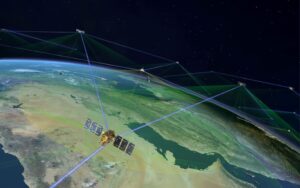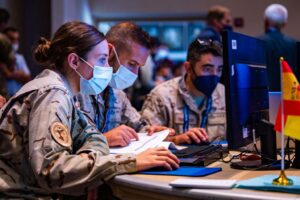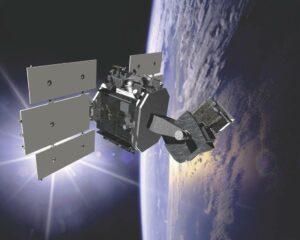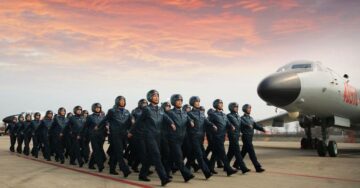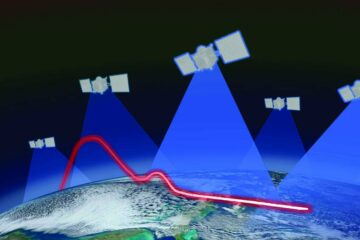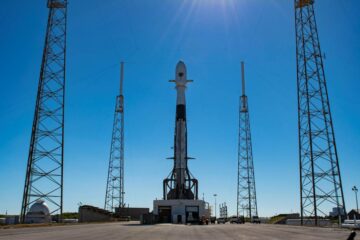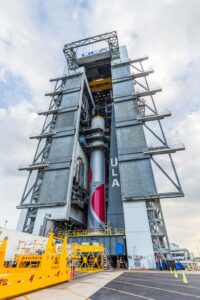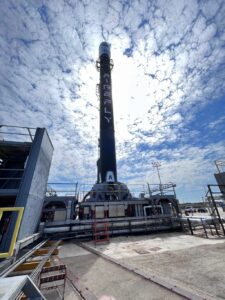
WASHINGTON — To meet their goal of being AI-ready by 2025, the U.S. Air Force and Space Force must invest to train and retain a skilled workforce and develop a strong digital infrastructure, according to the services’ outgoing chief of data and AI operations.
Maj. Gen. John Olson, who also serves as the mobility assistant to the Chief of Space Operations and the lead for Joint All-Domain Command and Control for the Air Force and Space Force, will transition out of the CDAO role Jan. 14. He told C4ISRNET Jan. 7 the services have strengthened their data and AI infrastructure and built a stronger workforce, but there is still more to do.
“We’re working that in earnest, we’re vigorously pursuing it. But we’re by no means there,” Olson said in an interview following his speech at the Consumer Technology Association’s CES conference in Las Vegas.
The Department of the Air Force’s AI readiness target and its parallel goal to be competitive in the field by 2027 are rooted in broader Defense Department imperatives to improve foundational AI and data capabilities across the services. They’re also informed by China’s push to be the world leader in AI by 2030. Olson stressed that because data underpins military technology and operations, it’s important that DoD stay ahead of its adversaries in this area.
“I firmly believe that the nation that does lead in AI will lead the world because it’s critically important to everything that we do,” he said.
Bolstering the services’ readiness levels will take investment in training and a greater recognition of the importance of reliable, secure data and analysis, Olson said. At the infrastructure level, it will require an enterprise IT architecture.
In the last year, Olson and the data team have prioritized establishing a Department of the Air Force data catalog as a key step toward making information sets available to users. The services have also been developing tools to improve personnel systems, digital operations, logistics and financial processes — and they’re seeing results. As an example, Olson said using improved data tools for annual budget planning has turned what used to be weeks-long tasks into work that can be completed in hours or minutes.
“This is the transformative power of data products for us,” he said.
To support greater testing and training, Olson said, the services last year established what’s called the Autonomy, Data and AI Experimental Proving Ground at Eglin Air Force Base in Florida. The new tool will allow the Air Force to experiment with autonomy concepts like manned and unmanned teaming and drone swarming and build plans for its future Collaborative Combat Aircraft. Olson said the service showcased ADAX for the first time in mid-December, drawing more than 150 people from across DoD as well as interagency partners.
As he moves out of his CDAO role, Olson said he hopes the Air Force and Space Force continue to pursue these projects with a greater sense of urgency.
“I think we need to accelerate,” Olson said. “We need to be much more focused and operating with a much greater sense of urgency.”
- SEO Powered Content & PR Distribution. Get Amplified Today.
- Platoblockchain. Web3 Metaverse Intelligence. Knowledge Amplified. Access Here.
- Source: https://www.defensenews.com/artificial-intelligence/2023/01/10/air-force-space-force-pursue-ai-readiness-by-2025/
- 7
- 70
- a
- accelerate
- According
- across
- ADAX
- ahead
- AI
- AIR
- Air Force
- aircraft
- analysis
- and
- annual
- architecture
- AREA
- Assistant
- available
- base
- because
- being
- believe
- budget
- build
- built
- called
- capabilities
- catalog
- Ces
- chief
- Chinas
- collaborative
- combat
- competitive
- Completed
- concepts
- Conference
- consumer
- consumer technology
- continue
- control
- data
- Defense
- Defense Department
- Department
- develop
- developing
- digital
- DoD
- drawing
- drone
- Enterprise
- established
- establishing
- everything
- example
- experiment
- field
- financial
- firmly
- First
- first time
- florida
- focused
- following
- Force
- from
- future
- Gen
- goal
- greater
- Ground
- hopes
- HOURS
- HTTPS
- images
- importance
- important
- improve
- improved
- in
- information
- informed
- Infrastructure
- Interview
- Invest
- investment
- IT
- Jan
- John
- Key
- Las Vegas
- Last
- Last Year
- lead
- leader
- Level
- levels
- logistics
- Making
- means
- Meet
- Military
- minutes
- mobility
- more
- moves
- nation
- Need
- New
- operating
- Operations
- Parallel
- partners
- People
- planning
- plans
- plato
- Plato Data Intelligence
- PlatoData
- power
- prioritized
- processes
- Products
- projects
- Push
- Readiness
- recognition
- reliable
- require
- Results
- Role
- Said
- secure
- seeing
- sense
- Sense of Urgency
- serves
- service
- Services
- Sets
- skilled
- Space
- Space Force
- speech
- stay
- Step
- Still
- strong
- stronger
- support
- Systems
- Take
- Target
- tasks
- team
- Technology
- Testing
- The
- the world
- their
- time
- to
- tool
- tools
- toward
- Train
- Training
- transformative
- transition
- Turned
- u.s.
- U.S. Air Force
- urgency
- us
- users
- VEGAS
- What
- WHO
- will
- Work
- Workforce
- working
- world
- year
- zephyrnet

